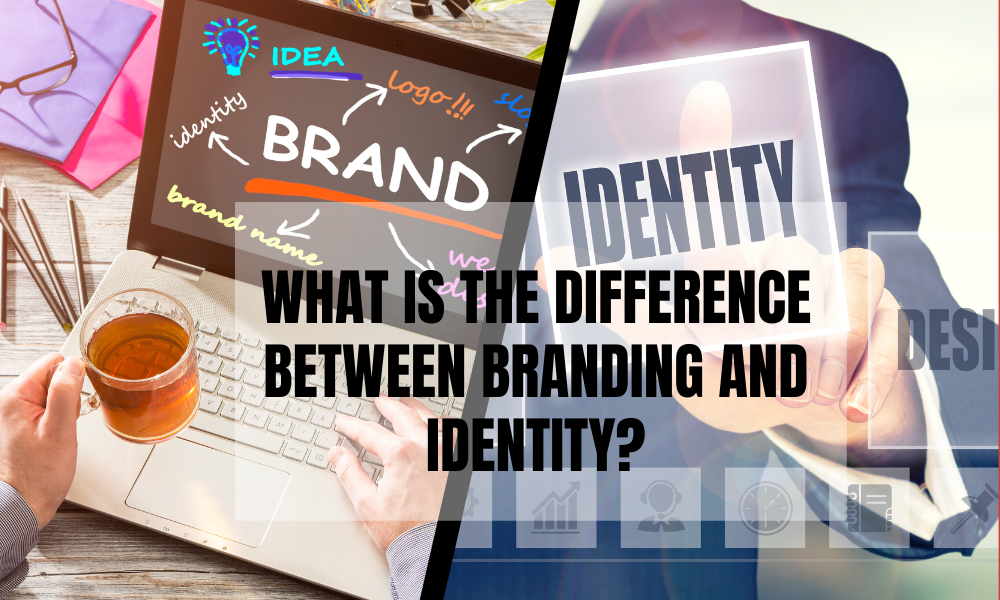What Is the Difference Between Branding and Identity?

What is branding?
Essentially, branding is a set of marketing and psychological techniques and steps to promote a company, product, service, or even character in order to create a brand. In turn, a brand can be defined as a set of distinctive features that contribute to the recognition of a product or service in the market. This is what people think and know about it.
So, branding is how users will perceive the product by interacting with it. We are talking about the visual image of the brand, its communication and reputation. And a well-thought-out design based on research, analysis, understanding of both the target audience and business goals becomes the silent brand ambassador.
What is the difference between branding and identity?
Brand Naming Agency: In short: branding is soul. Identity is a person. Branding is any experience of interaction with your company, product or service. It’s not just about your customer base. Your target audience or anyone else makes up their vision of your brand, working with it online and offline.
Thus, even though it is an important part, the logo is not a brand or branding. Just like packaging, posters, branded mugs, caps or t-shirts are not a brand if taken out of context, strategy and environment.
A brand is the strategy itself, the message being conveyed, the story being told, the benefits presented, all with a deep understanding of the target audience, as well as the context, channels and medium of communication with it.
Your brand is the user or customer experience at every point of contact with the product. Branding is vital as it lets customers know what to expect. It is a process used to increase customer awareness and loyalty.
When working on branding, first of all, it is necessary to determine the “soul” of the brand. This helps create a strong brand and identity, a “face” for products and companies. From the brand model to the design system, an identity is created that communicates the values of the company or product.
When to start the branding process?
Typically, the branding process begins when:
- Are you launching a new company or a new product?
- You need to revitalize your brand identity.
- A company or product name has changed.
- Do you feel it’s time to create an integrated system?
- It’s time for a change and you want to renew your brand.
- When companies merge, a new approach is needed.
What specialists work on brand creation?
Branding projects are always teamwork. The best cases are born in close contact with the client’s team. It is important to openly discuss the goals and vision of the brand so that the new identity shines brightly and authentically.
Also Read: How to Start LLC Company in India
Only a team can create a strong successful brand, making every effort to achieve results:
- The art director is responsible for artistic supervision and quality control of the entire branding project.
- The graphic designer is responsible for creating all the graphics of the project, including the logo and all branded items.
- The brand strategist is responsible for the brand research and model phases and will be involved in all stages of the process to ensure that all graphic solutions are in line with the chosen branding direction.
- A motion designer would create catchy animations to brighten up a design concept (such as a logo animation).
- A copywriter is involved if a new naming, slogan and text preparation is required.
- The project manager liaises with the client and the team throughout the project to facilitate the process.
What are the steps in the branding process?
Stage 1: Research
Research helps to better understand the brand, its customers and markets. At this stage, you need:
- Clarify the vision, strategies, goals and values of the brand!
- Explore user needs and perceptions.
- Conduct direct and indirect research on competitors in the market!
- Interviews with decision makers
- Evaluate existing content and marketing materials (in case of rebranding)
- Present and discuss the research so that the teams are on the same vector.
During this phase, the brand strategist explores market insights with the team that can be useful for product positioning and visuals.
The research is based on the materials and content of the current brand, available materials related to direct and indirect competitors. If there are completed surveys or in-depth market research done by the client’s marketing team or research partner, these are always welcome.
Also Read: Historical Brand Name
Stage 2: Brand Model
Brand positioning is the basis for visual effects and communication. To determine it, work is underway on the brand model. An effective brand model provides a central, unifying message around which all behavior, actions, and communications will align.
Brand strategy defines positioning, differentiation, competitive advantage, and unique value proposition. In general, it creates a vision aligned with the business strategy, based on the values and culture of the company, and reflects a deep understanding of the needs and perceptions of the client.
At this stage it is necessary to carry out:
- Summarizing lessons learned from research.
- Clarify the essence of the brand and its main advantages.
- Create brand user images.
- Develop Key Messages
- Prepare some recommendations for communication.
Stage 3: Design
The design approach is a carefully selected set of visuals that convey moods and emotions, a collection of references that are collected to create a design. In this way, a synchronization of the vision of identity is created.
The design approach includes style suggestions for:
- logo sign
- colors
- typography
- text style
- identification systems
- illustrations
- photo or video content
Together with the client, they discuss the visual direction that would best suit the brand. After approval, the development of the concept of a new style begins.
Stage 4: Design Concept
This step seems to be the most interesting. Considering all the previous steps, brainstorm and visualize the unique concept of your brand identity. The creative team represents identity and how to use it.
Stage 5. Creation of brand elements
Since branding is an experience, it is very important to consider all touch points – the places where the brand meets and talks with the target audience. Every touchpoint is a chance to increase brand awareness and customer loyalty.
To make your brand look great and embody its vision, you need to create points of contact with the target audience. It can be:
- Website, landing page.
- Advertising banners
- Promo or explainer videos
- Social media templates
- Presentations
- Event stand + any event materials
- Stationery
- Package design
- stickers, etc.
Once the branding package has been completed and approved, an identification guide is prepared to make it easy to work with the design system in the future.
What are identification rules and why are they needed.
The guidelines constitute a set of rules for how your new identity should be used in all media. It is a tool to help ensure consistent implementation of identity elements across all touchpoints.
Identification rules include:
- Use of the logo. Where and how to use your logo, including minimum sizes, spacing, monochrome use, etc.
- Colour palette. Rules and proportions for the use of colours, which colours should and should not be combined, as well as a breakdown of colours for printing and stencilling.
- Use of typography. Information about specific fonts and font family details, as well as information about functional font pairings and usage/combination rules.
- Image style, illustrations, use of photography. These guidelines are optional depending on the chosen visual style.
- Use of graphic elements. The graphic style and elements are what make up the whole identification system. These are guidelines and tutorials (if necessary) so that the marketing or design team can easily use the identity and keep it consistent.
- Use of applications. All branded items included in the kit (e.g., app icon, business cards, social media templates) are bundled together with assets for easy access.
The outcome of this process will guide you through every marketing decision you make. This will help improve the relationship between your brand and the customer. By applying your ideas, you will also gain new perspectives to strengthen corporate culture and employee engagement.
Visit Newsbosst for More Information



